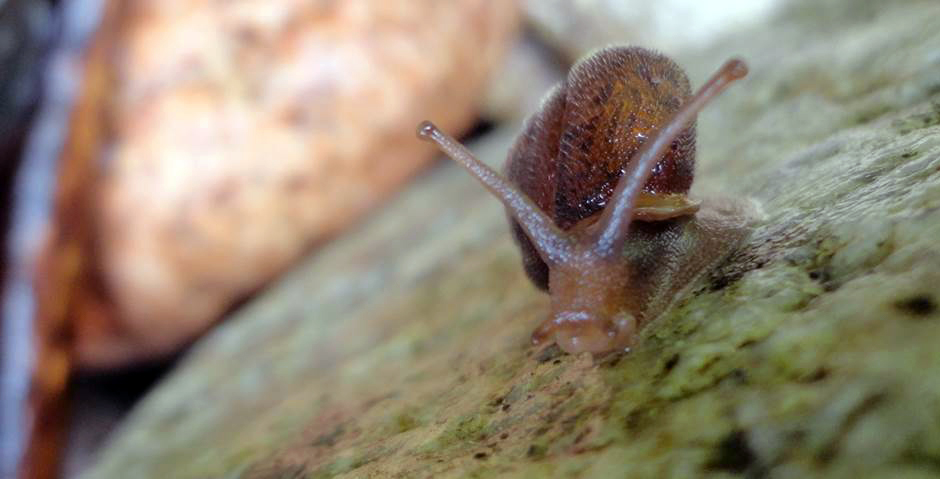Northwest hesperian • Vespericola columbianus
Identification
The northwest hesperian has a light yellowish-brown disc-shaped shell (heliciform: width is greater than height) with a low conical spire. The lip of the shell aperture (opening for the body) is expanded out into a small flare, but is not thicker than the rest of the shell. The shell's periostracum is usually densely covered in small hairs, giving the shell a fuzzy appearance, but this varies with subspecies.* The shell is thin and fragile. The snail's body is brownish with some darker, greyer areas.
*The taxonomic status of Vespericola columbianus subspecies, as well as other Vespericola, appears to be unresolved; Burke lists four subspecies, one of which (V. c. columbianus) either lacks hairs on its shell as an adult, or only has a few scattered hairs. Based on distribution, the likely subspecies candidate for the snail shown above is an as-yet unnamed one (currently designated V. c. ssp.) that was previously grouped with V. c. pilosa before the latter — which was known from a population near San Francisco — was shown to be a distinct species.
Habitat & Range
This species is found in moist forested habitats from sea to subalpine elevations, as well as under driftwood along grassy seashores. It is found throughout the coastal Pacific Northwest from Unalaksa Island, Alaska to Oregon. While it is usually found west of the Coast-Cascade Mountains, it may be found further eastward into the Interior Wetbelt region, where moist coastal air reaches and provides suitable habitat.
Similar Species
This currently appears to be the only known species of Vespericola present in coastal BC, as well as Alaska and Washington. The pygmy Oregonian (Cryptomastix germana), a much smaller species, is also hairy but its hairs are longer, less densely-spaced, and curved.
The northwest hesperian has a light yellowish-brown disc-shaped shell (heliciform: width is greater than height) with a low conical spire. The lip of the shell aperture (opening for the body) is expanded out into a small flare, but is not thicker than the rest of the shell. The shell's periostracum is usually densely covered in small hairs, giving the shell a fuzzy appearance, but this varies with subspecies.* The shell is thin and fragile. The snail's body is brownish with some darker, greyer areas.
*The taxonomic status of Vespericola columbianus subspecies, as well as other Vespericola, appears to be unresolved; Burke lists four subspecies, one of which (V. c. columbianus) either lacks hairs on its shell as an adult, or only has a few scattered hairs. Based on distribution, the likely subspecies candidate for the snail shown above is an as-yet unnamed one (currently designated V. c. ssp.) that was previously grouped with V. c. pilosa before the latter — which was known from a population near San Francisco — was shown to be a distinct species.
Habitat & Range
This species is found in moist forested habitats from sea to subalpine elevations, as well as under driftwood along grassy seashores. It is found throughout the coastal Pacific Northwest from Unalaksa Island, Alaska to Oregon. While it is usually found west of the Coast-Cascade Mountains, it may be found further eastward into the Interior Wetbelt region, where moist coastal air reaches and provides suitable habitat.
Similar Species
This currently appears to be the only known species of Vespericola present in coastal BC, as well as Alaska and Washington. The pygmy Oregonian (Cryptomastix germana), a much smaller species, is also hairy but its hairs are longer, less densely-spaced, and curved.
References
Burke, T. E. Land Snails and Slugs of the Pacific Northwest. (2013). Corvallis, OR: Oregon State University Press. Pp. 172-176.
Forsythe, R. Vespericola columbianus (I. Lea, 1839). In Klinkenberg, Brian. (Ed.) E-Fauna BC: Electronic Atlas of the Fauna of British Columbia. Lab for Advanced Spatial Analysis, Department of Geography, University of British Columbia, Vancouver. Accessed 14/03/2016.
Authors and editors of page
Kelly Fretwell (2016). Identification assistance from Kristiina Ovaska.
Burke, T. E. Land Snails and Slugs of the Pacific Northwest. (2013). Corvallis, OR: Oregon State University Press. Pp. 172-176.
Forsythe, R. Vespericola columbianus (I. Lea, 1839). In Klinkenberg, Brian. (Ed.) E-Fauna BC: Electronic Atlas of the Fauna of British Columbia. Lab for Advanced Spatial Analysis, Department of Geography, University of British Columbia, Vancouver. Accessed 14/03/2016.
Authors and editors of page
Kelly Fretwell (2016). Identification assistance from Kristiina Ovaska.




